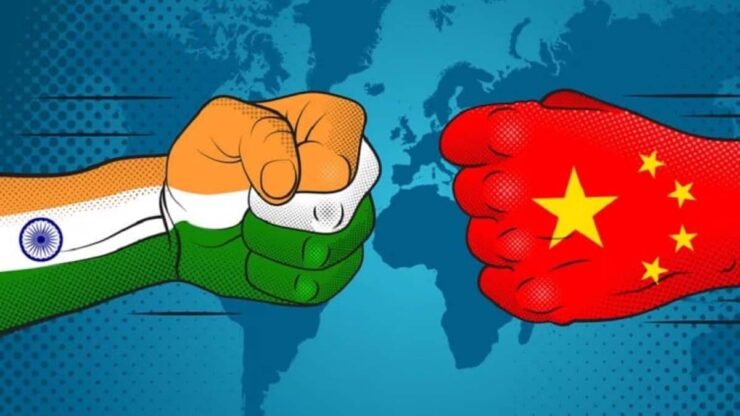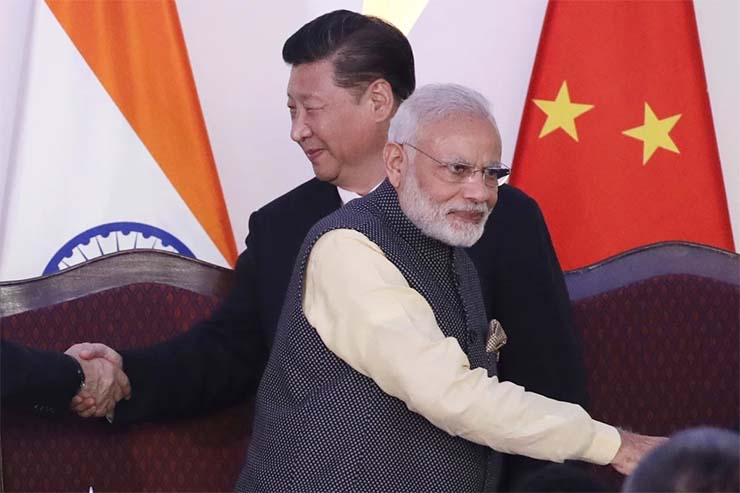
If India starts a war, it will definitely lose – Global Times- a state-sponsored Chinese Communist Party newspaper known for its conspiracy theories, and disinformation predicted in one of its editorials.
“New Delhi needs to be clear about one thing: It will not get the border the way it wants. If it starts a war, it will definitely lose” Global Times said.
“First, we should stick to the principle that no matter how India makes trouble, China’s territory belongs to China and we will never cede it. India is still sleepwalking on the border issue. We can wait for it to wake up,” Global Times the publication sometimes called “China’s Fox News” because of its propagandistic slant added.
Surprisingly, this was endorsed by an Indian analyst who said that “India’s ground force posture and strength in the border areas is not comparable with China which has the decisive edge because of better military infrastructure, capabilities, and logistics.”
“In case of an Indo-China war in the near future, India will lose the war as well as Arunachal Pradesh and Ladakh within ten days. There is very little that India can do about it”, he predicted.
According to the analysts quite like the Gulf War or Operation Desert Storm in 1991 in which the US military and its techno-savvy coalition partners used all kinds of Global Positioning Systems (GPS), Airborne Warning and Control Systems (AWACS), sensors, precision-guided munitions, cluster bombs, Scud and Patriot missiles and satellite communication systems – China will overwhelm India using multi-domain operations, imaginative war concepts and emerging technologies like artificial intelligence, and combat robots.
The analyst argued that China has been preparing for this eventuality since the Doklam crisis in 2017 and has been consistently consolidating its offensive and defensive capabilities along the Line of Actual Control – leading to one too many stand-offs with the Indian side without any tangible results.
Hence according to him, the Indian security forces stand nowhere close to countering the Chinese man-machine warfighting capabilities in case of an outright conventional or nuclear war in which the strength, bravery, and valor of the Indian soldiers cannot match the PLA’s superiority and domination in the seven crucial domains namely – air, land, sea (including deep-sea), outer space, cyberspace, electromagnetic, and hypersonic domain.
As a result, India will be forced to surrender within the first seventy-two hours as the primary battleground will not be on land but in cyberspace and the electromagnetic spectrum, he insisted.
While this might be a possibility; it appears to be far-fetched as the protagonists of this theory largely base their premise on the presumption that China is “far superior” and convincingly beat the ill-prepared, and poorly equipped Indian Army in 1962. Hence it can do so again in 2023 too.
There were a number of reasons why India failed to counter China’s threats leading to the ignoble defeat in 1962. For instance:
- India was blissfully ignorant of Chinese territorial claims. The maps published by Beijing in 1954 showed the Aksai Chin region as Chinese territory, however, instead of raising the issue with China or taking the country into confidence, the Nehru government chose to remain quiet.
- While the Chinese forces made rapid advancement into Indian Territory, Nehru and his Defence minister V.K. Krishna Menon were literally caught with their pants down because of the mistaken belief that China would not attack India.
3.Interfering politicians and the blundering generals did not allow the Indian Army to fight as it could have. - Political favoritism and interference in Defence matters like the appointment of incompetent officers like Lt Gen B.M. Kaul as the IV Corps commander which was a blunder that weakened the morale of the Indian Army rank and file.
- Both IAF and the Indian Navy were not deployed during the Sino-Indian War in 1962. This proved to be a grave mistake as the Chinese did not have the fuel or runways long enough to use their own air force. The IAF had more modern and capable aircraft than the Chinese air force. The IAF could also carry far more bomb load than the Chinese air force and attack cities like Lhasa, Kunming, and Chengdu.
- United States and the United Kingdom refused to sell advanced weaponry, compelling India to turn to the Soviets for military aid and the sale of fighter aircraft.
- The Nehru government was more interested in removing Defence Minister Krishna Menon than in fighting the war.
This proved to be a costly mistake as much of the territory across the LAC and McMahon Line that China today claims to be it’s own was captured by the PLA in 1962.
Those who know history – know it well that history doesn’t always repeat itself – if you learn from it. India today is certainly not the India of 1962, and so is the art of warfighting.
Even though China militarily has a quantitative edge over the Indian armed forces, in terms of fighter aircraft, diesel-electric submarines, and rocket artillery, the Chinese PLA is a ‘Paper Tiger’ with no battlefield experience, like the Indian Army.
Ironically, on the verge of his retirement, Chinese Lt. Gen. He Lei is reported to have confessed that his biggest regret was that he never fought a war. “I am retiring soon. My one big regret is that I never had a chance to fight in a war,” he was quoted as saying.
The grim reality is that the Chinese PLA today, has an increasingly impressive array of high-tech weapons and equipment but does not have the experience to use them in combat.

The situation is almost similar to that in 1943 when the inexperienced U.S. troops suffered a humiliating defeat at the Kasserine Pass in Tunisia in their first major against the German forces during World War II. As a result, the United States paid the price with the lives of around 6,500 men. This example clearly shows how inexperience leads to poor decision-making, weak battlefield performance, and high casualties.
Almost every branch of the Chinese military – the PLA Army, Navy, and Air Force lacks the necessary skills to execute complex missions and campaigns. This is largely due to the fact that the last war it fought was against Vietnam in 1979 – when most of its current officers and men were babies at home. In 1979 even though the Chinese army had numerical superiority in almost every aspect – men, guns, tanks, they failed to achieve a decisive victory against the Vietnamese, because their troops were no match for the better-trained and combat-experienced Vietnamese soldiers.
The lesson learned from this is that the military’s ability to fight and win wars cannot be changed overnight. This is something that President Xi Jinping, the chairman of the Central Military Commission, also knows but can’t do much about. The last few combat veterans who fought the war will soon retire. This means that the Chinese military will eventually have nobody with firsthand combat experience.
According to a recent study report by the Center for a New American Security (CNAS), “India is by far the more experienced and battle-hardened party, having fought a series of limited and low-intensity conflicts in its recent past—from the Kargil conflict of 1999 to the cross-border artillery shelling, special operations forces (SOF) raids, and aerial skirmishing that now seem to have become a ubiquitous feature of the Indo-Pakistani rivalry. The PLA, on the other hand, has not experienced the crucible of combat since its conflict with Vietnam in 1979, and the few remaining veterans of that vicious border war are now nearing retirement. Indian troops also regularly engage in increasingly sophisticated joint exercises with the world’s most advanced and combat-experienced militaries, thus providing additional opportunities for gains in operational proficiency. Western troops participating in such war games and exercises regularly have expressed a grudging admiration for their Indian counterparts’ tactical creativity and a high degree of adaptability. China’s joint training endeavors, on the other hand, thus far have remained relatively rudimentary in scope— with the notable exception of its increasingly advanced military exercises with Pakistan and Russia.”
Painting a possible scenario in case of a conflict the report added, “Upon the outbreak of armed hostilities, India, using a combination of jamming, satellite dazzling, and offensive cyber operations, would degrade China’s sensor architecture covering the LAC. This would diminish the PLA’s ability to quickly find, fix, and finish Indian forces at the outset of the conflict. Delhi would inject misinformation into China’s local battle management networks—for example, using deep fakes to convey false orders—to create confusion among PLA forces operating along the LAC or inside Indian Territory. Rather than attempt a perimeter defense along the LAC, India would hold vital strong strong points and allow limited PLA incursions that in turn could be isolated, surrounded, and eliminated, or held at risk for future political concessions. To prevent or at least slow the flow of follow-on PLA echelons, India would target rail lines in the TAR as well as key roads with a combination of missile strikes, SOF, and, where practical, offensive cyber operations. As India’s land-, air-, and space-based sensors suffered attrition at the hands of the PLA, New Delhi would increasingly rely on foreign strategic partners, both to maintain awareness of China’s movements within the TAR and to conduct battle damage assessments of strikes on China’s infrastructure. During the conflict (and in a departure from the current operational concept), India would refrain from engaging in large-scale mechanized assaults across the LAC, as the less complex topography of the Tibetan Plateau and the high signatures of such armored columns would render them acutely vulnerable to PLA air, missile, and artillery strikes. However, if the initial costs imposed on the PLA proved insufficient, Delhi would deploy its irregular forces beyond the LAC to foment insurgency in Tibet.”
According to reports the Chinese PLA officers and soldiers today are facing acute stress, anxiety, and nervousness due to engagement with India along the Line of Actual Control (LAC) and with the US over the South China Sea and Taiwan.
“The People’s Liberation Army has introduced counseling services, regular assessments and courses to help troops deal with the stress of their assignments and cope in combat,” South China Morning Post a Hong Kong-based newspaper reported.
Ironically not only the Chinese army but even the Air Force and Navy are facing these issues because such deployment and military activities are a new development for the Chinese military which has never been deployed in such harsh weather where temperatures drop to -50 degrees and the enemy is always facing you along the LAC.
Some of the symptoms of such physical and psychological issues in high-altitude areas include hair loss, impotency, and loss of appetite.
Conclusion
The unspoken reality is that China has many disadvantages if it dares to attack India as it would need to deploy at least six Chinese divisions to counter each Indian division along the LAC and McMahon Line. This is because an attacker in the mountains needs more troops than the defender. By this logic China would need at least 45 -50, army divisions- however, the big question is where will these additional troops come from that too in the treacherous terrain and harsh Himalayan winter.
India on the other hand has a “Ghatak” platoon of battle-ready soldiers ready to pounce on them and trained to kill with their bare hands.
As Sun Tzu says in The Art of War, “If you know the enemy and know yourself, you need not fear the result of a hundred battles. If you know yourself but not the enemy, for every victory gained you will also suffer a defeat. If you know neither the enemy nor yourself, you will succumb in every battle…”
-The writer is a seasoned media professional with over three decades of experience in print, electronic, and web media. He is presently Editor of Taazakhabar News








